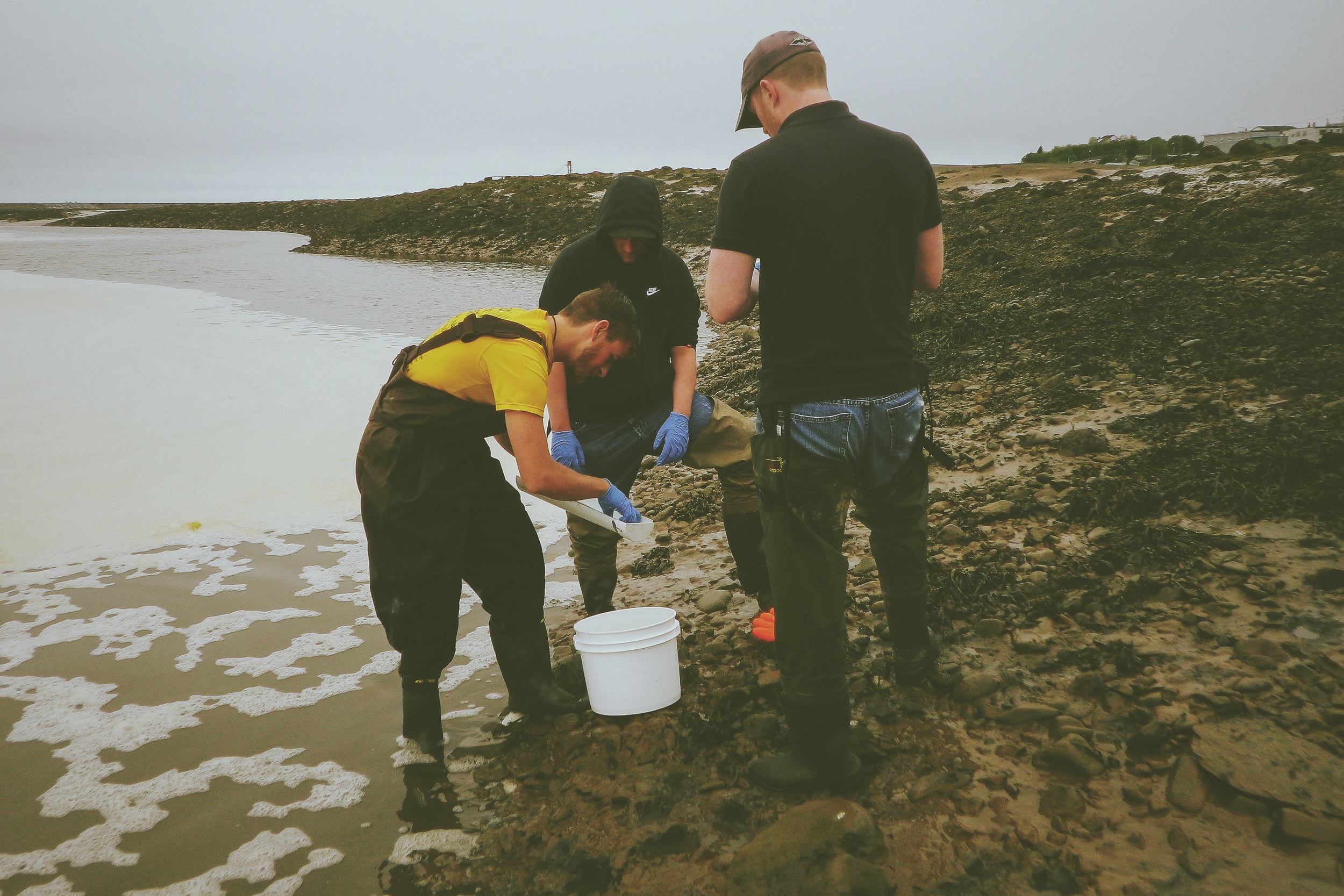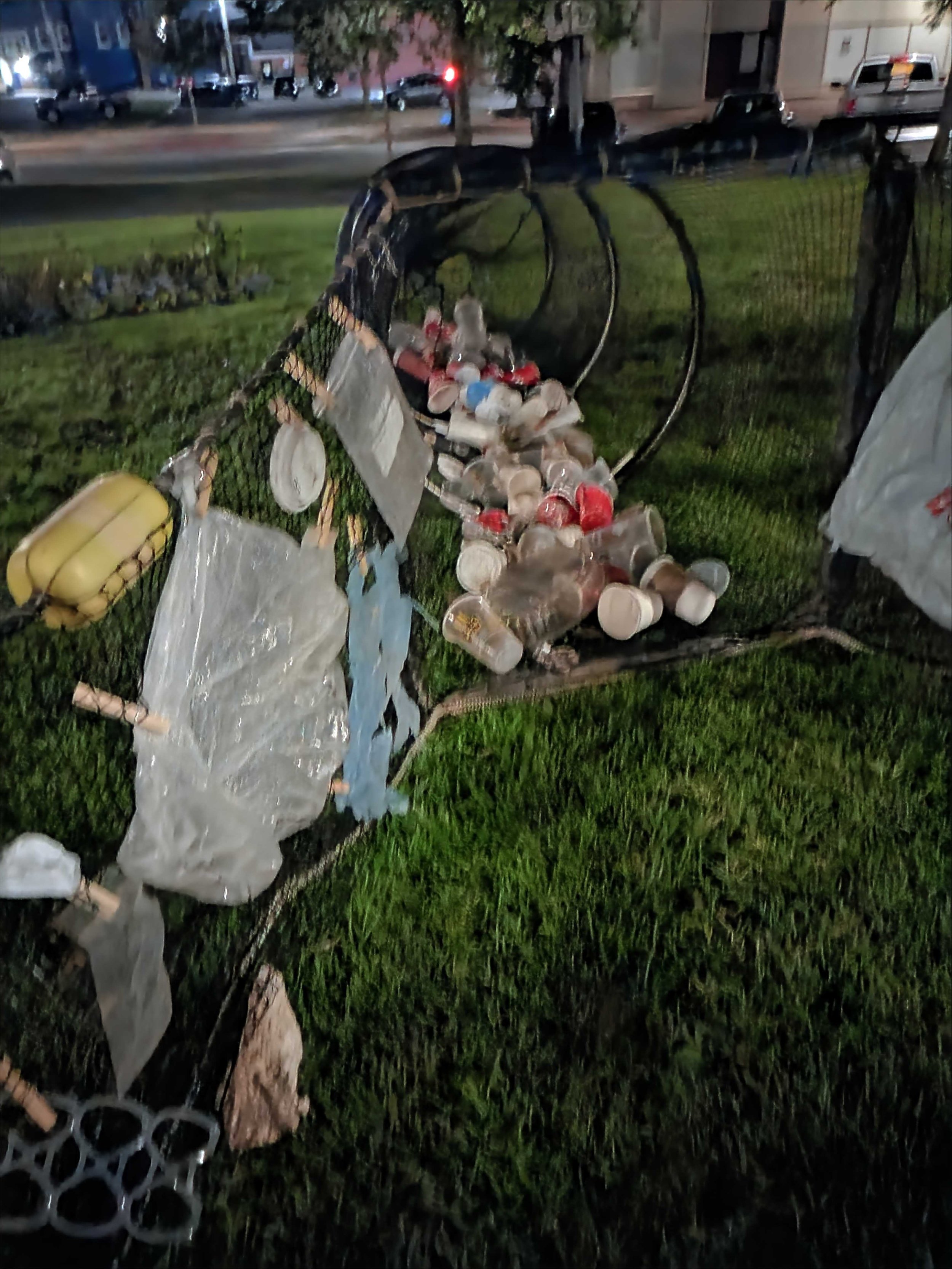
STAFF BLOG
What a Catch! Or is it?
Guest blog contributed by: Julia Macpherson
This year at THIRD SHIFT, a contemporary art festival, ACAP Saint John contributed an installation that displayed various pieces of pollution and debris found in and around Saint John entitled What a Catch!
ACAP Saint John’s installation of What a Catch! at the 2022 THIRD SHIFT festival.
Rhino filled with bottle caps in Wales (2017).
Jamylynn McDonald, the mind behind the concept of the sculpture, has been collecting bottle caps from the ground since her travels in Wales where she was inspired by a sculpture of a rhino filled with bottle caps. Wanting to raise awareness of the abundance of single-use plastics polluted daily, she and the rest of the ACAP team worked together to collect litter from the beaches and rivers around Saint John.
This is not ACAPs first effort to inform the public of the incredulous amounts of pollution found around Saint John waterways. Previously, they have held workshops on identifying single use plastics, promoted the use of filters that remove microfibers in washing machines, and are collaborating with Coastal Action (Mahone Bay, NS) to estimate types and quantities of microplastics in the Southern Gulf of St. Lawrence and the Wolastoq [St. John River] watershed.
As the name suggests, microplastics are pieces of plastic less than 5 mm long that are found in the environment¹. Microplastics can be introduced into an environment through the break-down of larger pieces of plastic, wastewater, product manufacturing, etc.². Although small, the introduction and accumulation of microplastics into aquatic environments can have big effects. In fact, while they have been identified since the late nineties, these pesky pieces of plastic have provoked a new area of research in the past 20 years. In this emerging field, much has been discovered about the potential impact of microplastics in marine, freshwater and terrestrial environments.
Yet, microplastics are not the only issue.
Fyke net displaying a majority of the trash collected along beaches around the Saint John harbour.
From the copious amounts of litter collected by ACAP in just two months, it’s no surprise that our very own Bay of Fundy and Wolastoq [St. John River] are no strangers to pollution and have been the subject of plastic pollution research.
Plastic pollution in waterways surrounding Saint John goes beyond the micro scale, another common type is abandoned, lost, and discarded (ALD) fishing gear³. This form of marine pollution is a serious threat to marine life as it can lead to ingestion, entanglement, and may eventually degrade into microplastics³.
Lobster traps filled with fishing rope and plastic bottles as part of ACAP’s THIRD SHIFT display.
A 2020 study found that 28% of the debris found on the ocean floor of the Bay of Fundy was ALD fishing gear including: rope, lobster traps, bait bags, gloves, etc. Meanwhile, other types of pollution such as plastic bags, cables, metal and tires make up the remaining 72%³.
The problem isn’t limited to aquatic environments either, the same study found marine debris on the groups surrounding the Bay of Fundy, particularly on the sand and gravel³. Narrowing back in on the micro-scale, a study done in the Kennebecasis and Tobique watersheds found that 92% of collected mussels were found to have microfibers in their tissues⁴. Mircrofibers, a type of microplastic, are shed from textiles and end up in the environment via laundry wastewater⁴. Like larger pieces of plastic pollution, in small organisms, microfibers can be ingested and carry toxic additives⁴. Whether present on the ocean-floor, sand, or river, the presence of plastic pollution is a danger to natural environments.
Much like the plastic debris around the Saint John Watershed, public awareness on this environmental issue should be everywhere. Jamylynn and the ACAP team demonstrates the ubiquity and challenges of plastic pollution and marine debris through What a Catch! Not only as an eye-catching display but also as a powerful message, What a Catch! successfully highlights the reality of the state of the environment in Saint John.
References
1. NOAA. What are microplastics? National Ocean Service Website, https://oceanservice.noaa.gov/facts/microplastics.html#:~:text=Plastic%20debris%20can%20come%20in,as%20some%20cleansers%20and%20toothpastes
2. IUCN. Primary Microplastics in the Oceans: a Global Evaluation of Sources. https://portals.iucn.org/library/sites/library/files/documents/2017-002-En.pdf
3. Goodman, A. J., Walker, T. R., Brown, C. J., Wilson, B. R., Gazzola, V., & Sameoto, J. A. (2020). Benthic marine debris in the Bay of Fundy, eastern Canada: Spatial distribution and categorization using seafloor video footage. Marine Pollution Bulletin, 150, 110722. https://doi.org/10.1016/j.marpolbul.2019.110722
4. Doucet, C. V., Labaj, A. L., & Kurek, J. (2021). Microfiber Content in Freshwater Mussels from Rural Tributaries of the Saint John River, Canada. Water, Air, & Soil Pollution, 232(1), 32. https://doi.org/10.1007/s11270-020-04958-4
About the author
Julia Macpherson
Julia (she/her) is a 2nd year master’s student at the University of New Brunswick (Saint John) and also holds a B.Sc. in marine and freshwater biology from the University of Guelph. While currently a full-time student, Julia is also interested in science communication and outreach and hopes to continue in this field. In her spare time she enjoys camping, nature photography and running.













